Top-rated Sigma lenses for taking all kinds of photos.
Sigma has become a dominant force in the lens market. Nowadays, there is a vast selection of models to choose from, and it may seem a real challenge to find the best option. For you not to go through the selection process on your own, I have reviewed the best Sigma lenses, so that you can make an informed decision before parting with your money.
If you didn’t find a certain lens model on this list, it means that I haven’t tested it yet, or the lens isn’t good enough to be reviewed. In case this overview doesn’t entail the best option for you, check out the other lens-focused articles that include comprehensive verdicts.
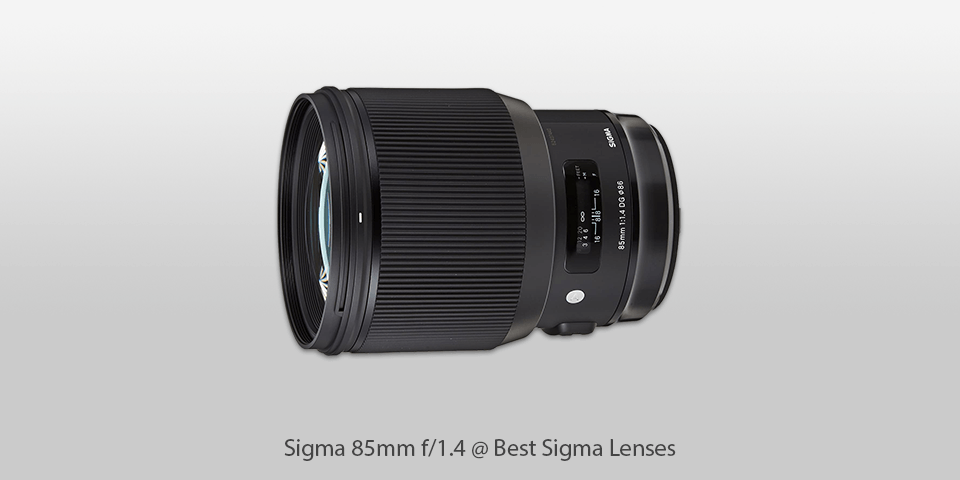
Mount: E | Diaphragm blades: 9 | Autofocus: yes | Min focus distance: 85cm | Max magnification: 0.12x | Filter thread: 86mm | Dimensions (WxL): 94.7 x 126.2 mm| Weight: 1130 g
⊕ Sharp results
⊕ Offers a bright f/1.4 aperture
⊕ Doesn’t produce distortion
⊕ Uniform illumination
⊖ Bulky
⊖ Doesn’t include a built-in image stabilization system
⊖ It is necessary to adjust the focus
The Sigma 85mm F1.4 DG HSM Art hit the market due to its exceptional optical performance and the ability to capture the tiniest details even if you shoot wide open at f/1.4. This model is popular among photographers due to its aperture size. The quality of construction isn’t inferior to its top-tier optical system, although this Sigma lens has a lower price bracket compared to its Canon and Nikon contenders.
The only downside of this model is the lack of an image stabilization system. However, if it is important for your photography and you are fine with an f/1.8 aperture, the Tamron SP 85mm is another great and even more affordable option. Nevertheless, if you are on the lookout for an f/1.4 lens, the Sigma 85mm is worth being the number one choice.
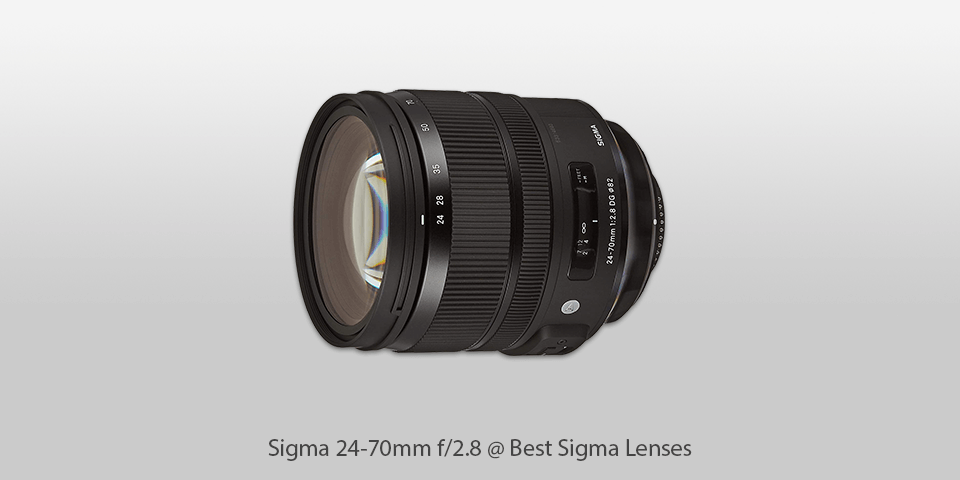
Mount: EF | Diaphragm blades: 9 | Autofocus: yes | Min focus distance: 37cm | Max magnification: 0.21x | Filter thread: 82mm | Dimensions (WxL): 88 x 107.6 mm| Weight: 1020 g
⊕ Offers consistency
⊕ Image stabilization system
⊕ Durable construction
⊕ Dust and splash-resistant
⊖ Poor sharpness at edges at f/2.8
⊖ Dark corners
⊖ Produces chromatic aberration
⊖ Some image distortion
The Sigma 24-70mm F2.8 DG OS HSM Art is a reasonably-priced lens that employs a wide-aperture standard zoom for full-frame sensors and an excellent optical stabilization system. Although this model doesn’t deliver such a sharpness level when shooting at wide angles as its Tamron contender, you can still enjoy high-quality images across the entire zoom range, even if you attach the lens to a high-resolution camera. The Tamron produces soft photos when shooting at 70mm wide open. However, this is an average result, especially if you are engaged in portrait photography.
If you don’t want to take time on image post-production and eliminate some blemishes in the photos, like chromatic aberration, distortion and vignetting, the Sigma Art lens will be a perfect replacement to more expensive models like the Nikkor 24-70mm f/2.8E and the Canon EF 24-70mm f/2.8L II USM. However, if you are a professional photographer, you’d better consider more expensive lenses. Such an investment will definitely pay off.
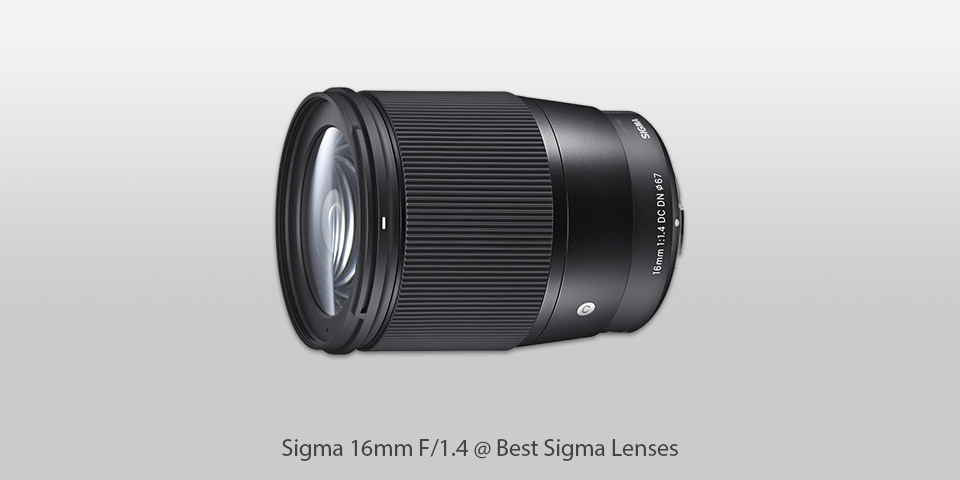
Mount: E | Diaphragm blades: 9 | Autofocus: yes | Min focus distance: 25 cm | Max magnification: 0,1x | Filter thread: 67mm | Dimensions (WxL): 72.2 x 92.3 mm| Weight: 405 g
⊕ Bright f/1.4 maximum aperture
⊕ Wide-angle field of view
⊕ Excellent sharpness
⊕ Uniform illumination
⊖ Slightly large for some Micro Four-Thirds cameras
⊖ Produces barrel distortion
⊖ Doesn’t offer optical stabilization
Although the Sigma 16mm F1.4 DC DN Contemporary costs $399, it fully justifies each dollar spent on it. Moreover, it isn’t inferior to more expensive Olympus and Panasonic optics designed for Micro Four Thirds cameras. Sony also doesn’t release models with such type of angle and impressive image quality and brightness. Even if you compare the Sigma 16mm F1.4 with the Sony 16mm f/2.8, the former model stands ahead with its well-elaborated design and sharp results it delivers.
The 16mm F1.4 is one of the best Sigma APS C lenses with an excellent angle of view and bright aperture. So, if these specifications work for you, this lens will be a perfect choice. You will hardly find a similar model for such a price. However, you can try the Sonnar T* E 24mm F1.8. Although it has similar capabilities with the Sigma 16mm F1.4, the Sonnar T* E 24mm offers a narrower aperture and is more than twice expensive.
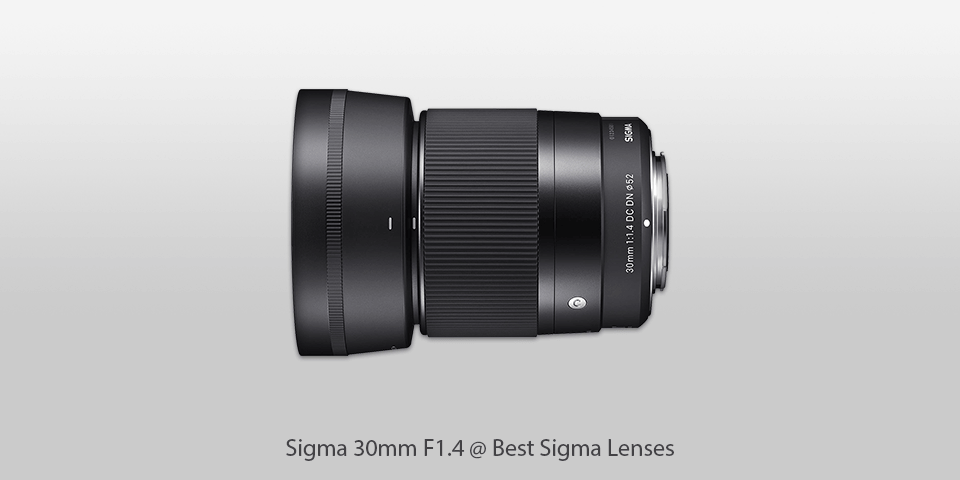
Mount: EF | Diaphragm blades: 9 | Autofocus: yes | Min focus distance: 30cm | Max magnification: 0.14x | Filter thread: 52mm | Dimensions (WxL): 64.8 x 73.3 mm| Weight: 265 g
⊕ Bright aperture
⊕ Excellent level of sharpness
⊕ Uniform illumination
⊕ Budget-friendly
⊖ Produces slight barrel distortion
⊖ Doesn’t offer image stabilization
⊖ Doesn’t include weather sealing
Being a budget-friendly model with a powerful optical system, the 30mm F1.4 DC DN Contemporary is one of the best Sigma lenses for those photographers who are comfortable with an f/1.4 aperture and want to get excellent nighttime photos. You will receive incredibly sharp images, especially if you shoot at f/2 and narrower settings.
Since the lens doesn’t offer built-in image stabilization, it is recommended to choose the cameras with an onboard optical stabilization system to achieve high-quality handheld photos and videos. However, if in-lens stabilization is essential for your photography, you’d better pay attention to the more expensive Sony 35mm f/1.8 OSS. The Sigma 30mm F1.4 DC DN Contemporary is a great performer for the price, but as always with lenses, it has some downsides. Nevertheless, if you have a good mirrorless camera and are searching for a fast, standard lens, this model will live up to all your expectations.
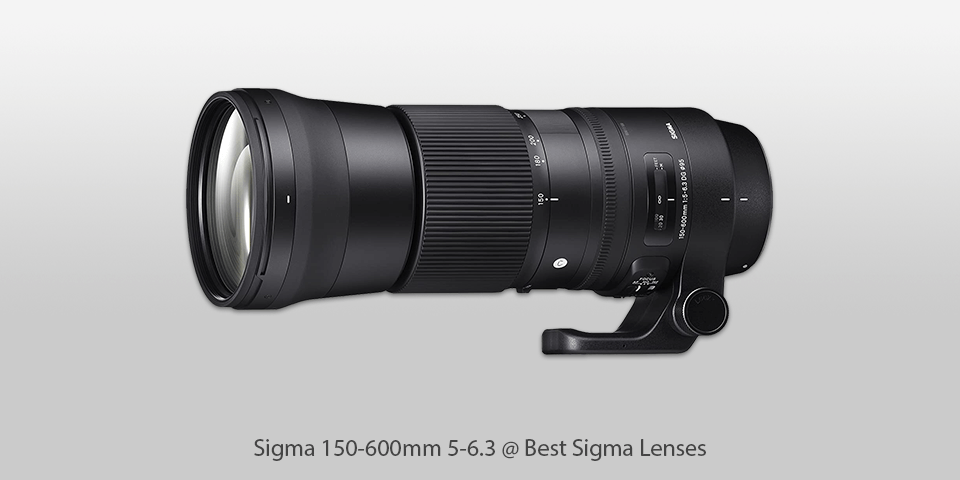
Mount: EF | Diaphragm blades: 9 | Autofocus: yes| Min focus distance: 2.8 m | Max magnification: 0.2x | Filter thread: 95mm | Dimensions (WxL): 10.2 x 4.1 x 4.1 inches| Weight: 4.3 Pounds
⊕ Great telephoto reach
⊕ Produces sharp images
⊕ Has tripod collar and lens hood
⊕ Fast focusing
⊖ Slight chromatic aberration
⊖ Modest pincushion distortion
⊖ Narrow aperture
⊖ Bulky
⊖ Not resistant to dust and splashes
The Sigma 150-600mm f/5-6.3 DG OS HSM Contemporary goes above its asking price with impressive image quality and excellent telephoto reach. Even at the max aperture, it delivers sharp edge-to-edge results. If you use the maximum telephoto settings, you can notice slightly soft corners and a little distortion in the image.
However, these aren’t essential drawbacks considering the price, size and weight of the lens. If you need a stronger performer, then pay attention to the Sports version of the lens. The 150-600mm f/5-6.3 DG OS HSM Contemporary is a decent option among cheap Sigma lenses that boasts impressive telephoto reach, quick focusing and good optical stabilization.

Mount: E | Diaphragm blades: 11 | Autofocus: yes | Min focus distance: 18cm | Max magnification: 0.34x | Filter thread: 82mm | Dimensions (WxL): 87.8 x 122.9 mm| Weight: 835g
⊕ Amazing sharpness
⊕ Image stabilization
⊕ Durable construction
⊖ Soft edges at f/2.8
⊖ Darkened corners
⊖ Visible chromatic aberration
⊖ Slight distortion
The Sigma 24-70mm F2.8 DG OS HSM Art competes with a similar model from Tamron in terms of a wide aperture standard zoom, full-frame SLRs compatibility, image stabilization and affordability. Even though it doesn’t deliver such sharp results at wider angles as the Tamron lens, the Sigma 24-70mm F2.8 produces reasonably sharp images across the entire zoom range, even when shooting on high-res cameras. The Tamron delivers soft images if you shoot wide open at 70mm, which isn’t enough, especially for portrait photographers.
If you are a beginner who doesn’t have enough skills to edit images in Photoshop or similar software to eliminate chromatic aberration, vignetting and distortion, the Sigma 24-70mm is a perfect option for a reasonable price. It is also an excellent alternative to pricier models such as the Nikkor 24-70mm f/2.8E and Canon EF 24-70mm f/2.8L II USM. However, if you are looking for the best Sigma lenses for professional purposes, it is recommended to consider a model with more advanced capabilities.
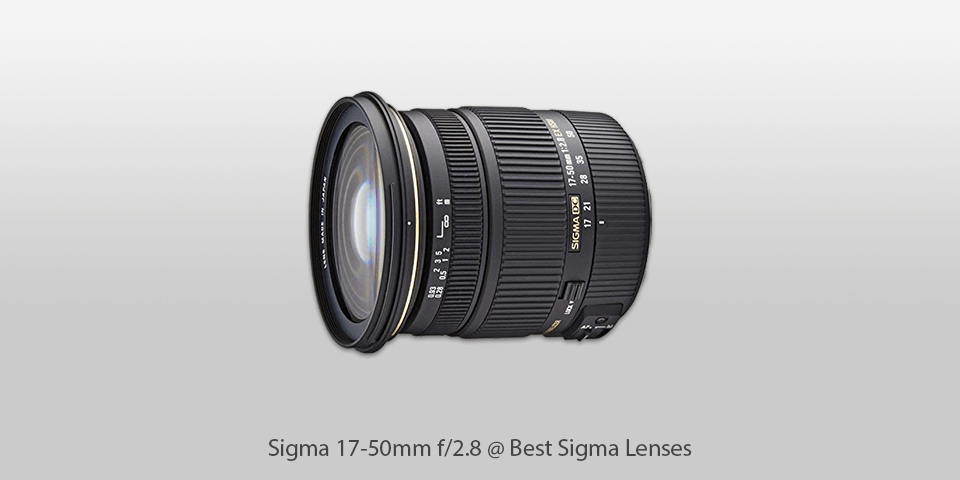
Mount: EF | Diaphragm blades: 7 | Autofocus: yes | Min focus distance: 28 cm | Max magnification: 0.2x | Filter thread: 77mm | Dimensions (WxL): 83.5 x 91.8 mm| Weight: 565 g
⊕ Robust construction
⊕ First-class image quality
⊕ General-purpose model
⊖ Some lens distortion
⊖ Manual focus ring issue
⊖ Isn’t fully weather-sealed
This Sigma zoom lens is an excellent option on a budget. Even if a certain amount of money doesn’t limit you, it is still a decent addition to your camera gear. With a fixed f/2.8 aperture, you will achieve excellent photos, even in low light situations.
If you want to replace your kit lens with high-quality and well-designed optics, then the Sigma 17-50mm EX DC OS HSM will be a sweet spot. You can use it for a wide variety of photography tasks, such as shooting landscapes, portraits and sporting events.
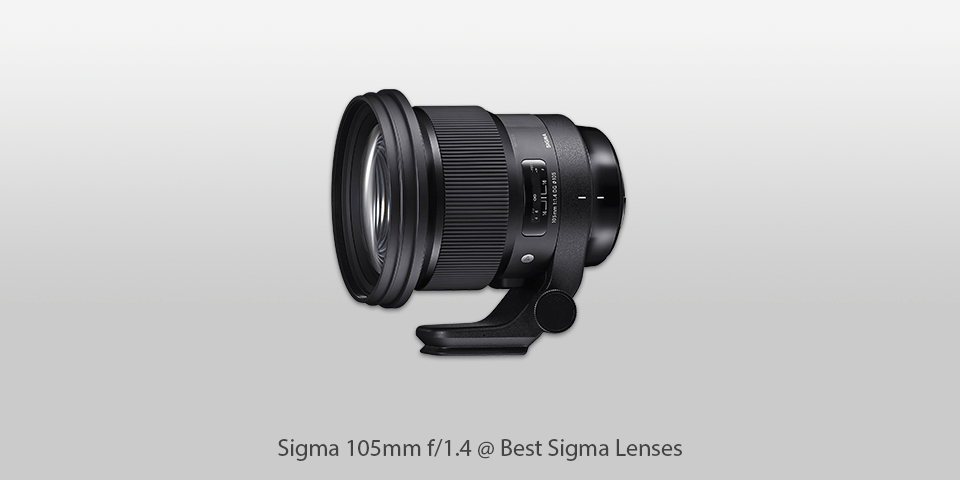
Mount: EF | Diaphragm blades: 9 | Autofocus: yes | Min focus distance: cm | Max magnification: 0.2x | Filter thread: mm | Dimensions (WxL): mm | Weight: g
⊕ First-class build quality
⊕ Consistent and accurate results
⊕ Low level of vignetting
⊖ Bulky and heavy
⊖ Isn’t compatible with teleconverters
⊖ Low magnification ratio
The 105mm f/1.4 is another powerful optical tool developed by Sigma. A 105mm lens with a huge maximum aperture of f/1.4 is a major break in the industry. The main downside of this model is its bulky and heavy design, but if you have adequate arm strength to wield the lens, you can use this top-tier model to boost your portrait photography.
This Sigma DG lens isn’t considered to be a mainstream option. It is more suitable for professional purposes rather than general use. Using this lens, you can take unique pictures without any hassles. Unlike a standard 70-200mm f/2.8 lens, it produces more impressive results. If you don’t consider its size and weight, the Sigma 105mm f/1.4 doesn’t have any strong disadvantages.
| Image | Name | Features | |
|---|---|---|---|
 |
Sigma 85mm f/1.4
Our choice |
CHECK PRICE → | |
 |
Sigma 24-70mm f/2.8
Professional |
CHECK PRICE → | |
 |
Sigma 16mm F/1.4
Budget |
CHECK PRICE → |

Each type of lens can be used for different photographic situations. Play around with your creativity and imagination to achieve the most unexpected results.
Being represented in millimeters, focal length defines how much of the scene will be captured. Prime lenses have a fixed focal length, while zoom lenses have a variable focal length.
If you use an APS-C camera, consider how the equivalent focal length of the particular lens can be calculated for your camera. Canon cameras have a 1.6 crop factor, while Nikon cameras come with a 1.5 crop factor.
There are ongoing debates among users which type of lens is better, with a fixed or variable aperture. Both primes and zooms may have a different type of lens aperture. Some users claim that fixed aperture lenses allow for a higher degree of creative control over your image. Others believe that lenses with a variable aperture deliver more flexibility. Aperture is labeled as f/#. A higher f-number implies a narrower opening through which light travels.
Not all lenses and cameras have onboard image stabilization. When you shoot handheld, it entails camera shake. It’s especially noticeable when you are shooting in low-light conditions. To achieve crisp pictures, you will need a lens with a built-in optical stabilization system.

Unlike other brands available on the market, Sigma releases lighter lenses due to their unique design and materials. Add the weight of your lens to the weight of your camera to understand how it feels like to hold the entire kit. The higher the focal length, the longer body the lens will have.
You can attach any Sigma Art lens to a camera with a full-frame sensor. Such lenses are designed based on the latest technologies to ensure top-notch results. They produce minimum distortion. Nevertheless, you can use Sigma Art lenses with APS-C as well. They deliver the most extraordinary results if you use a 35mm focal length.
Sigma Art lenses come with onboard image stabilization. In 2009, Sigma introduced three models that deliver exceptional image stabilization for Canon, Sony, Nikon and other camera brands. These are the 10-20mm, 18-50mm and the 50-200mm Sigma Art zoom lenses. After that, the manufacturer released a completely new Optical Stabilization (OS) system to prevent camera shake.
Sigma produces photography accessories that can work with different cameras. So, if you have a Nikon camera, feel free to shop for Sigma lenses. The majority of lenses by this manufacturer are compatible with a Nikon SLR mount, so you can attach them to most Nikon DSLRs and SLRs.
The process of lens focus calibration requires skills and patience. First off, you will need to download a focus calibration target and connect the lens to your computer using a Sigma USB Dock and Sigma Optimization Pro software. Mount your camera to the tripod and set it at 1.4/160 ISO 100. Adjust the center focus point to be directed to the center of the target, perfectly perpendicular to the sensor. With the Sigma USB dock, you can make four adjustments. To get a better look into the matter, it is recommended to carefully study the Sigma user manual or watch online video tutorials.

 Rating
Rating